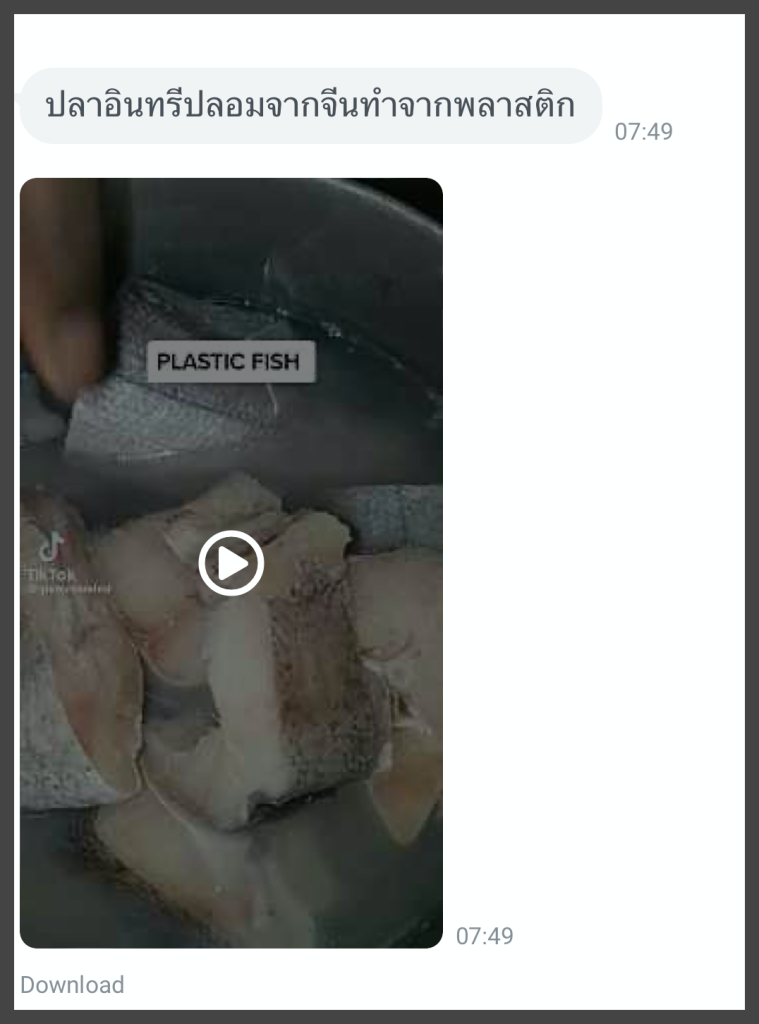
Recently, a video has been circulating online, warning about fake fish meat reportedly made from plastic in the market. This video has garnered widespread distribution.
Social Media Claims
We received a user request via our fact-checking LINE channel regarding a video that claims fish meat is made from plastic. This video has been widely circulated on the LINE platform.

We also found that this video has been widely shared on Facebook and TikTok.
Explanation from the Experts
We have investigated the origin of the video in question and discovered that it has been circulating on social media since 2017. We located a permanent link to the website Hoaxorfact.com that evaluated this video, which explains that the fish texture in the video is due to freezer burn. This condition arises when meat undergoes repeated freezing and thawing, resulting in cell membrane breakdown and dehydration, which eliminates the natural texture of animal flesh. Moreover, fish that has been frozen for a prolonged period may take on a spongy appearance, as shown in the video. If fish meat remains in water for too long, it absorbs water and begins to resemble a sponge.
Freezer burn is a process where frozen food loses its moisture because of sublimation, which is when water transitions directly from a solid to a gaseous state. This change makes the food drier, harder, and often changes its color. Foods that contain a lot of water, like fruits, meats, poultry, fish, or ice cream, are more likely to get freezer burn. Even though freezer burn can affect the food’s texture, color, and taste, it’s still safe to consume if it was fresh when frozen and properly thawed. However, the quality won’t match that of food that hasn’t been freezer burnt or is fresh. (Source)
Professor Dr. Wisit Javasit, a lecturer at the Center for Innovation and Reference on Food for Nutrition (CIRFON), Mahidol University, clarified to Sure And Share that the assertion in the video about fish meat being made from plastic is not true. The fish meat’s condition is due to improper freezing and storage. This happens because a typical refrigerator freezes slowly, causing ice crystals to permeate and damage the fish’s proteins. Additionally, exposure to air leads to oxidation, which makes the fish meat spongy. These issues can be avoided with rapid industrial freezing techniques. To prevent problems with frozen fish, it should be stored in a tightly sealed, thick bag, cut into small pieces, prepared quickly, and thawed slowly before cooking. (Source)
Moreover, the Safe Food Promotion and Support Office, Ministry of Public Health clarified about the video. They stated, “The fish in the video is not plastic but has been frozen for a long time, causing freezer burn. Upon defrosting, the fish will display the characteristics mentioned, including brownish-gray spots on its meat and skin—typical of fish that has been frozen for extended periods.” (Source)
In summary, the video’s claim that the fish is made from plastic is incorrect. The fish’s sticky texture, which resembles plastic or sponge, is due to improper storage. This causes ice crystals to penetrate the fish meat, destroying the protein and leading to a spongy texture.
Follow us and stay up to date with our latest fact checks.
Facebook | Twitter | Instagram | LINE | TikTok | WhatsApp

Title:Debunking The Viral “Fake Fish From Plastic” Video
Fact Check By: Cielito WangResult: Insight




